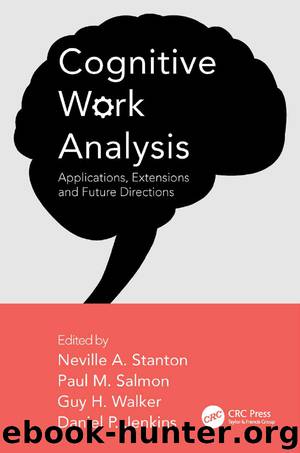Cognitive Work Analysis by Stanton Neville A. Salmon Paul M. Walker Guy Jenkins Daniel P

Author:Stanton, Neville A.,Salmon, Paul M.,Walker, Guy,Jenkins, Daniel P.
Language: eng
Format: epub
Publisher: CRC Press LLC
Published: 2017-05-13T04:00:00+00:00
10
Conducting Cognitive Work Analysis with an Experiment in Mind
Sean W. Kortschot, Cole Wheeler, Aimzhan Zhunussova and Greg A. Jamieson
Contents
10.1Introduction
10.1.1The Power Plant
10.1.2Nuclear Control Room Displays
10.2Analysis
10.2.1Experimental Design
10.2.2Scenario Selection
10.2.3Breadth and Depth of Analysis
10.2.4Work Domain Analysis
10.2.5Control Task Analysis and Strategies Analysis
10.3Results: EID Displays
10.4Discussion
References
10.1Introduction
Nuclear power accounts for an estimated 21% of Organisation for Economic Cooperation and Development (OECD) countries’ total energy production (World Nuclear Association, 2015). Although nuclear represents a viable option for large-scale carbon-free power production, the potential consequences of disaster are severe, with the radiation from accidents such as Fukushima and Chernobyl still being felt today (Fushiki, 2013). Although nuclear accidents can occur for a variety of reasons, post-accident reports from Chernobyl, the Three-Mile Island accident and Fukushima found that human error either directly contributed to the accident (Meshkati, 1998; Lau et al., 2012) or significantly exacerbated the accident’s impact (Suzuki, 2014). Consequently, designers have placed a much greater emphasis on understanding and improving the ways in which the human operators interact with and control nuclear power plants. One of the signature features of this improvement in recent years has been the inclusion of large screen displays (LSDs) in the control room (Myers and Jamieson, 2013).
LSDs are typically wall-mounted displays that enable multiple control room operators to share a common point of reference (Myers and Jamieson, 2013). LSDs are postulated to improve both operator situation awareness (SA), and collaboration and communication within operating teams (Roth et al., 1998). Although these claims seem intuitively logical, an operating experience review by Myers and Jamieson (2013) revealed (1) that there is little empirical evidence substantiating their inclusion in nuclear control rooms and (2) that there has been minimal research directed at evaluating what information content and structure best evoke these postulated benefits. Our work attempts to amend these gaps in the literature by conducting an experiment that will (1) investigate how effective LSDs perform in relation to other display types and (2) investigate different methods for displaying plant parameters on those LSDs.
Download
This site does not store any files on its server. We only index and link to content provided by other sites. Please contact the content providers to delete copyright contents if any and email us, we'll remove relevant links or contents immediately.
| Automotive | Engineering |
| Transportation |
Whiskies Galore by Ian Buxton(41722)
Introduction to Aircraft Design (Cambridge Aerospace Series) by John P. Fielding(33019)
Small Unmanned Fixed-wing Aircraft Design by Andrew J. Keane Andras Sobester James P. Scanlan & András Sóbester & James P. Scanlan(32687)
Craft Beer for the Homebrewer by Michael Agnew(18084)
Turbulence by E. J. Noyes(7897)
The Complete Stick Figure Physics Tutorials by Allen Sarah(7269)
Kaplan MCAT General Chemistry Review by Kaplan(6825)
The Thirst by Nesbo Jo(6765)
Bad Blood by John Carreyrou(6479)
Modelling of Convective Heat and Mass Transfer in Rotating Flows by Igor V. Shevchuk(6356)
Learning SQL by Alan Beaulieu(6162)
Weapons of Math Destruction by Cathy O'Neil(6087)
Man-made Catastrophes and Risk Information Concealment by Dmitry Chernov & Didier Sornette(5880)
Digital Minimalism by Cal Newport;(5590)
Life 3.0: Being Human in the Age of Artificial Intelligence by Tegmark Max(5407)
iGen by Jean M. Twenge(5330)
Secrets of Antigravity Propulsion: Tesla, UFOs, and Classified Aerospace Technology by Ph.D. Paul A. Laviolette(5240)
Design of Trajectory Optimization Approach for Space Maneuver Vehicle Skip Entry Problems by Runqi Chai & Al Savvaris & Antonios Tsourdos & Senchun Chai(4957)
Electronic Devices & Circuits by Jacob Millman & Christos C. Halkias(4867)
